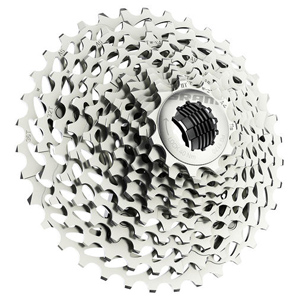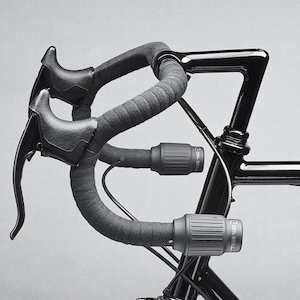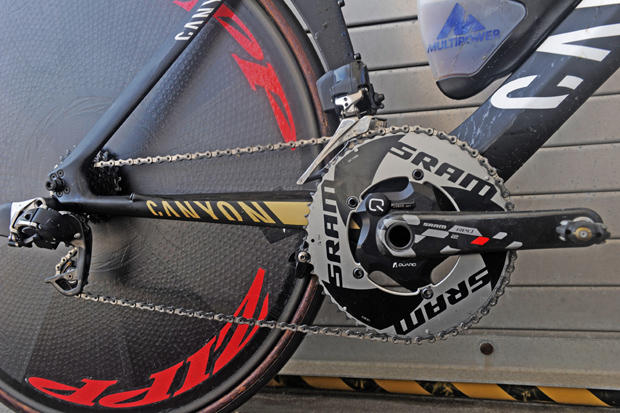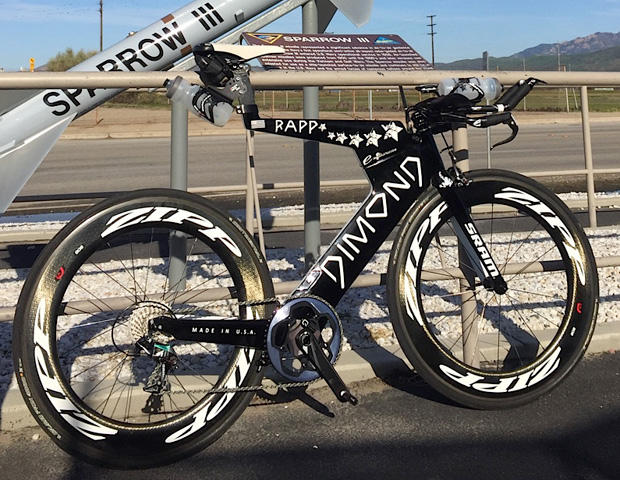SRAM and the American Psyche

I'm writing about components this week, and I'm going to start with a little intro-to-SRAM, not about its products, but what this company means in the grand scheme. I'm also going to talk about what Shimano, Campagnolo, FSA-Vision and other companies mean. Where they slot in. Today it's SRAM.
I'm not a chest pounder for the country in which I live. I love my country. But I don't believe we're the best country in the world anymore than I believe my wife is the best wife in the world. Yes, I am very happy with, and proud of, both my wife and my country, and I'm a very lucky man to live with my wife and in my country. But it demeans you – if you have a wife other than mine (which I hope is the case) and live in a country other than mine – when I say that mine is better than yours. If I refuse to proclaim the superiority of what is mine this does not (as some insist) diminish everything special about my wife, my country, my religion, my politics, my dog or – so that you know where this is going – my groupkit.
The above established, I don't know that cyclists in the U.S. understand the significance of SRAM. When I entered cycling as a serious, high-end enthusiast, in the 1970s, there was nothing made in my home country that I would want to ride. Yes, we had a vibrant cycling industry. We had Schwinn and Roadmaster. We had Huffy. We all had these bicycles growing up, but only for commuting to school and riding around the neighborhood.
If you wanted to race bikes you looked East. Not to the Far East. Not yet, that would come later. You looked to Europe. You might have purchased an Italian bike, or French, or an English bike like my first race bike, a Raleigh International. I then bought a used Colnago Super frameset (Eddy Merckx's bike) and moved the parts over. I sold that Raleigh frame and lost track of it. I was at bike check-in at the first Ironman ever held in Kona, in 1981, when Ken Shirk came walking up wearing a headdress with horns (he's better known as Cowman), rolling my old Raleigh.
As for my Molteni Orange Colnago Super, it's below with me aboard it in the first-ever triathlon I produced, the Lakeside Nautilus Second Sole Triathlon in Reno, Nevada in 1982. (The order was bike-run-swim and a LOT of the races in the earliest days of triathlon were draft-legal, like this one.)

The groupkit on my Raleigh, then my Colnago, was Campagnolo Nuovo Record. That's what just about everyone rode. There were 5 cogs in the back, shifting was on the down tube, and the freewheel was not part of the hub. That was a separate piece threaded onto the hub, and Regina made both the freewheels and the chains we used. If we didn't ride Campagnolo we might have ridden Huret, Simplex, or Stronglight – French parts makers – or maybe Spanish Zeus parts (pronounced zay-oos when referring to the parts). Our handlebars and stems were 3T, Modolo or Cinelli, our rims were Fiamme, Ambrosio, Mavic. Tires were always tubular (sew-ups) and we always glued on Clement, maybe Vittoria, maybe Wolber tires, in that order.
Not an American part anywhere. Not the tire, rim, shifters, not the frame, the crank, the saddle, nothing. The very last thing you'd want underneath you was anything made in America, except possibly a frame made in Schwinn's Paramount workshop.
Circa 1984 we began to move to Shimano and its 6-speed click-shifting and, man, I have never, from that day to this, seen a brand (Campagnolo) go from preeminence, and I mean an absolute brand hegemony, to a fall-from-glory so quickly. The desired drivetrain and groupkit parts just shot right over us, here in America, at 40,000 feet, from Europe to the Far East.
But not bike brands. Trek, Specialized and Cannondale were not seen as important brands in high-end cycling in the 1980s, but they figured out the switch to Asian manufacture or, at least, Asian parts, faster than anyone else. They were better placed than Schwinn and Huffy to make higher-end bikes, and reacted more quickly to Asia than did the European brands.
It was Serotta, first, that gave Americans a high-end brand to cheer about. Just as important was Kestrel, founded by a pair of ex-Trek executives in 1986. This brand made a bike in a style that would change the world of cycling and America, finally, made something high-end cyclists knew was not only a path to the future, but a path conceived of in America.
At that same time a handful of guys in cycling's Rust Belt got together and made a twist shifter meant to operate on the ends of road bars, much like thumb shifters. Was it a winning idea? Hardly. Plus, SRAM? What kind of name is that? Looks like a typo. There are some letters missing. Did they mean STRAM? Or SCRAM?
What we (well, I, as a matter of fact!) discovered back in the late 80s was that this twist shifter worked very nicely on the ends of aerobars we had just begun riding (just below is Emilio De Soto behind a Quintana Roo Superform outfitted with original Scott aerobars and SRAM Gripshifts), and this is what we rode by 1988 or '89 (this image would have been from '89 or '90.
The first bar-end shifters were Shimano's thumb shifters and SRAM twist shifters, both made for the ends of road bars, that is, both were products retasked as bar-end shifters. (My introduction of the first widely-accepted triathlon wetsuit, the first manufactured aerobar, and SRAM's twist shifter all debuted in 1987.)
The other thing that helped SRAM was that twist shifters worked very well for mountain bikers. This was great timing. MTB was, in the late 80s, fast becoming and important segment in cycling.

SRAM's folks have always been resourceful. They are experts at negotiating the landscape, adapting, finding the sweet spot. They are also great at integrating technologies, finding people smarter than themselves, finding companies to buy that either have industrial capabilities, or patents, that SRAM lacks. They have at various times bought Sachs-Huret (giving them derailleurs and chains), Truvativ (hubs, cranks and bottom brackets), Zipp (wheels, hubs, rims), Avid (braking systems), Quarq (power meters) and RockShox (offroad forks and suspension systems).
Having deftly assembled the building blocks to an entire road group, we all awoke one morning to names like Red, Force, Rival, Apex, the "family" names analogous in theme to Campagnolo's Super Record, Chorus, Veloce, and Shimano's Dura Ace, Ultegra, 105, Tiagra. America had its own component company.
SRAM has not, in my opinion, survived and thrived through out-performing Shimano and Campagnolo in the performance of core drivetrain components like derailleurs, chains, cranksets, brakes. Its métier is exploiting the sweet spot others refuse to acknowledge or are slow to address. Does SRAM shift, year in and year out, better than Shimano or Campagnolo? Are its cranks better? Its brakes? SRAM hasn't thrived by outperforming in core function areas. It's been competitive. Good enough. And then it finds the opening. As in, be the first of the Big-3 to widely product 110mm bolt pattern cranks (i.e., compact cranks); or produce 11-26, 11-28, or 11-32 cassettes, or whatever it is the market wants and cannot find. Or the first to produce widely-available road disc hydraulic groupkits. Or be the first of the Big-3 component companies to make a TT-specific bar-end shifter and plug-in brake lever. Power meters built into its cranks. Front Derailleurs that don't need to trim, though in this last example it was SRAM's unique, creative, maybe brilliant, and maybe desperate attempt to get around patents that had previously crippled (in my opinion) SRAM's ability to make a properly operating front derailleur.

Then there are the intangibles that make the company easy to root for, like one of the founding brothers (Stan and FK Day) resigning his duties to devote his time to bringing bicycles to poor, rural Africans, in an effort to fundamentally change the way family economies operate, village by village.
It has not always been clear sailing. Fights with Shimano over supply chain pricing. A crucial infusion of cash from Lehman Brothers almost derailed by Lehmann Brothers' collapse in 2008. The late introduction (still not introduced) of an electronic shift system (the one notable area where Shimano adapted to a new reality and it was SRAM who held back). Shimano hasn't stood still. Its worldwide sales have doubled in the last decade. Its bicycle sales are probably four times SRAM's sales.
But SRAM has always been the little train that could. Its sales increase, on a percentage basis, outstripped Shimano's between 2005 and 2010, the last year of any revenue data I've seen.
Companies like Specialized, Cannondale, Trek, and SRAM represent a change in the cycling landscape during my cycling lifetime that can't be overstated. While I'm not by nature jingoistic and a hyper-nationalist, I do take solace in the knowledge that American ingenuity might be an actual thing. We did not ride fast in the 70s, compared to the rest of the world. And we did not ride American. Today we do ride fast, and today we can ride American.
This does not keep me from riding Shimano and Campagnolo, or FSA, and I hike my legs over bikes with these fine components on a regular basis. In fact, SRAM is underneath me only about half of my riding time. It's just nice to know that I'm not obliged to always ride foreign-made bikes and parts, as was the case when I began cycling.



